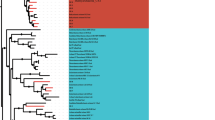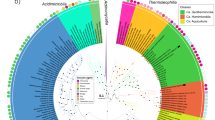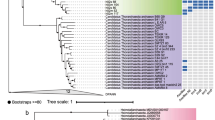Abstract
Members of the archaeal phylum Bathyarchaeota are widespread and abundant in the energy-deficient marine subsurface sediments. However, their life strategies have remained largely elusive. Here, we provide genetic evidence that some lineages of Bathyarchaeota are acetogens, being capable of homoacetogenesis, a metabolism so far restricted to the domain Bacteria. Metabolic reconstruction based on genomic bins assembled from the metagenome of deep-sea subsurface sediments shows that the metabolism of some lineages of Bathyarchaeota is similar to that of bona fide bacterial homoacetogens, by having pathways for acetogenesis and for the fermentative utilization of a variety of organic substrates. Heterologous expression and activity assay of the acetate kinase gene ack from Bathyarchaeota, demonstrate further the capability of these Bathyarchaeota to grow as acetogens. The presence and expression of bathyarchaeotal genes indicative of active acetogenesis was also confirmed in Peru Margin subsurface sediments where Bathyarchaeota are abundant. The analyses reveal that this ubiquitous and abundant subsurface archaeal group has adopted a versatile life strategy to make a living under energy-limiting conditions. These findings further expand the metabolic potential of Archaea and argue for a revision of the role of Archaea in the carbon cycle of marine sediments.
This is a preview of subscription content, access via your institution
Access options
Subscribe to this journal
Receive 12 digital issues and online access to articles
$119.00 per year
only $9.92 per issue
Buy this article
- Purchase on Springer Link
- Instant access to full article PDF
Prices may be subject to local taxes which are calculated during checkout




Similar content being viewed by others
References
Kallmeyer, J., Pockalny, R., Adhikari, R. R., Smith, D. C. & D'Hondt, S. Global distribution of microbial abundance and biomass in subseafloor sediment. Proc. Natl Acad. Sci. USA 109, 16213–16216 (2012).
Hoehler, T. M. & Jorgensen, B. B. Microbial life under extreme energy limitation. Nature Rev. Microbiol. 11, 83–94 (2013).
D'Hondt, S. et al. Distributions of microbial activities in deep subseafloor sediments. Science 306, 2216–2221 (2004).
Biddle, J. F. et al. Heterotrophic Archaea dominate sedimentary subsurface ecosystems off Peru. Proc. Natl Acad. Sci. USA 103, 3846–3851 (2006).
Bowles, M. W., Mogollon, J. M., Kasten, S., Zabel, M. & Hinrichs, K. U. Global rates of marine sulfate reduction and implications for sub-sea-floor metabolic activities. Science 344, 889–891 (2014).
Pedersen, K. et al. Numbers, biomass and cultivable diversity of microbial populations relate to depth and borehole-specific conditions in groundwater from depths of 4–450 m in Olkiluoto, Finland. ISME J. 2, 760–775 (2008).
Lever, M. A. et al. Acetogenesis in deep subseafloor sediments of the Juan de Fuca Ridge Flank: a synthesis of geochemical, thermodynamic, and gene-based evidence. Geomicrobiol. J. 27, 183–211 (2010).
Lipp, J. S., Morono, Y., Inagaki, F. & Hinrichs, K. U. Significant contribution of Archaea to extant biomass in marine subsurface sediments. Nature 454, 991–994 (2008).
Kubo, K. et al. Archaea of the Miscellaneous Crenarchaeotal Group are abundant, diverse and widespread in marine sediments. ISME J. 6, 1949–1965 (2012).
Lloyd, K. G. et al. Predominant archaea in marine sediments degrade detrital proteins. Nature 496, 215–218 (2013).
Fry, J. C., Parkes, R. J., Cragg, B. A., Weightman, A. J. & Webster, G. Prokaryotic biodiversity and activity in the deep subseafloor biosphere. FEMS Microbiol. Ecol. 66, 181–196 (2008).
Lloyd, K. G., May, M. K., Kevorkian, R. T. & Steen, A. D. Meta-analysis of quantification methods shows that archaea and bacteria have similar abundances in the subseafloor. Appl. Environ. Microbiol. 79, 7790–7799 (2013).
Meng, J. et al. Genetic and functional properties of uncultivated MCG archaea assessed by metagenome and gene expression analyses. ISME J. 8, 650–659 (2014).
Seyler, L. M., McGuinness, L. M. & Kerkhof, L. J. Crenarchaeal heterotrophy in salt marsh sediments. ISME J. 8, 1534–1543 (2014).
Lazar, C. B. et al. Genomic evidence for distinct carbon substrate preferences and ecological niches of Bathyarchaeota in estuarine sediments. Environ. Microbiol. http://dx.doi.org/10.1111/1462-2920.13142 (2016).
Evans, P. N. et al. Methane metabolism in the archaeal phylum Bathyarchaeota revealed by genome-centric metagenomics. Science 350, 434–438 (2015).
Puigbo, P., Wolf, Y. I. & Koonin, E. V. Search for a ‘Tree of Life’ in the thicket of the phylogenetic forest. J. Biol. 8, 59 (2009).
Schmidt, M. & Schonheit, P. Acetate formation in the photoheterotrophic bacterium Chloroflexus aurantiacus involves an archaeal type ADP-forming acetyl-CoA synthetase isoenzyme I. FEMS Microbiol. Lett. 349, 171–179 (2013).
Parizzi, L. P. et al. The genome sequence of Propionibacterium acidipropionici provides insights into its biotechnological and industrial potential. BMC Genomics 13, 562 (2012).
Rother, M. & Metcalf, W. W. Anaerobic growth of Methanosarcina acetivorans C2A on carbon monoxide: an unusual way of life for a methanogenic archaeon. Proc. Natl Acad. Sci. USA 101, 16929–16934 (2004).
Fournier, G. P. & Gogarten, J. P. Evolution of acetoclastic methanogenesis in Methanosarcina via horizontal gene transfer from cellulolytic Clostridia. J. Bacteriol. 190, 1124–1127 (2008).
Drake, H. L., Kusel, K. & Matthies, C. Ecological consequences of the phylogenetic and physiological diversities of acetogens. Antonie Van Leeuwenhoek 81, 203–213 (2002).
Henstra, A. M., Dijkema, C. & Stams, A. J. Archaeoglobus fulgidus couples CO oxidation to sulfate reduction and acetogenesis with transient formate accumulation. Environ. Microbiol. 9, 1836–1841 (2007).
Ettema, T. J. et al. Identification and functional verification of archaeal-type phosphoenolpyruvate carboxylase, a missing link in archaeal central carbohydrate metabolism. J. Bacteriol. 186, 7754–7762 (2004).
Mock, J., Wang, S., Huang, H., Kahnt, J. & Thauer, R. K. Evidence for a hexaheteromeric methylenetetrahydrofolate reductase in Moorella thermoacetica. J. Bacteriol. 196, 3303–3314 (2014).
Ragsdale, S. W. Enzymology of the Wood–Ljungdahl pathway of acetogenesis. Ann. NY Acad. Sci. 1125, 129–136 (2008).
Martin, W. F., Sousa, F. L. & Lane, N. Energy at life's origin. Science 344, 1092–1093 (2014).
Martin, W. F., Neukirchen, S. & Sousa, F. L. Microbial Evolution under Extreme Conditions 171–184 (de Gruyter, 2015).
Ueno, Y., Yamada, K., Yoshida, N., Maruyama, S. & Isozaki, Y. Evidence from fluid inclusions for microbial methanogenesis in the early Archaean era. Nature 440, 516–519 (2006).
Rothman, D. H. et al. Methanogenic burst in the end-Permian carbon cycle. Proc. Natl Acad. Sci. USA 111, 5462–5467 (2014).
Heuer, V. B., Pohlman, J. W., Torres, M. E., Elvert, M. & Hinrichs, K. U. The stable carbon isotope biogeochemistry of acetate and other dissolved carbon species in deep subseafloor sediments at the northern Cascadia margin. Geochim. Cosmochim. Acta 73, 3323–3336 (2009).
Lever, M. A. Acetogenesis in the energy-starved deep biosphere—a paradox? Front. Microbiol. 2, 284 (2011).
Biddle, J. F., Fitz-Gibbon, S., Schuster, S. C., Brenchley, J. E. & House, C. H. Metagenomic signatures of the Peru Margin subseafloor biosphere show a genetically distinct environment. Proc. Natl Acad. Sci. USA 105, 10583–10588 (2008).
Orsi, W. D., Edgcomb, V. P., Christman, G. D. & Biddle, J. F. Gene expression in the deep biosphere. Nature 499, 205–208 (2013).
Meador, T. B. et al. The archaeal lipidome in estuarine sediment dominated by members of the Miscellaneous Crenarchaeotal Group. Environ. Microbiol. 17, 2441–2458 (2014).
Drake, H. L., Gossner, A. S. & Daniel, S. L. Old acetogens, new light. Ann. NY Acad. Sci. 1125, 100–128 (2008).
Ovreas, L., Forney, L., Daae, F. L. & Torsvik, V. Distribution of bacterioplankton in meromictic Lake Saelenvannet, as determined by denaturing gradient gel electrophoresis of PCR-amplified gene fragments coding for 16S rRNA. Appl. Environ. Microbiol. 63, 3367–3373 (1997).
Jorgensen, S. L. et al. Correlating microbial community profiles with geochemical data in highly stratified sediments from the Arctic Mid-Ocean Ridge. Proc. Natl Acad. Sci. USA 109, E2846–E2855 (2012).
Song, Z. Q. et al. Bacterial and archaeal diversities in Yunnan and Tibetan hot springs, China. Environ. Microbiol. 15, 1160–1175 (2013).
Schloss, P. D. et al. Introducing mothur: open-source, platform-independent, community-supported software for describing and comparing microbial communities. Appl. Environ. Microbiol. 75, 7537–7541 (2009).
Pruesse, E. et al. SILVA: a comprehensive online resource for quality checked and aligned ribosomal RNA sequence data compatible with ARB. Nucleic Acids Res. 35, 7188–7196 (2007).
Peng, Y., Leung, H. C., Yiu, S. M. & Chin, F. Y. IDBA-UD: a de novo assembler for single-cell and metagenomic sequencing data with highly uneven depth. Bioinformatics 28, 1420–1428 (2012).
Dick, G. J. et al. Community-wide analysis of microbial genome sequence signatures. Genome Biol. 10, R85 (2009).
Li, H. & Durbin, R. Fast and accurate short read alignment with Burrows–Wheeler transform. Bioinformatics 25, 1754–1760 (2009).
Wrighton, K. C. et al. Fermentation, hydrogen, and sulfur metabolism in multiple uncultivated bacterial phyla. Science 337, 1661–1665 (2012).
Parks, D. H. et al. CheckM: assessing the quality of microbial genomes recovered from isolates, single cells, and metagenomes. Genome Res. 25, 1043–1055 (2015).
Noguchi, H., Park, J. & Takagi, T. MetaGene: prokaryotic gene finding from environmental genome shotgun sequences. Nucleic Acids Res. 34, 5623–5630 (2006).
Lagesen, K. et al. RNAmmer: consistent and rapid annotation of ribosomal RNA genes. Nucleic Acids Res. 35, 3100–3108 (2007).
Rawlings, N. D., Waller, M., Barrett, A. J. & Bateman, A. MEROPS: the database of proteolytic enzymes, their substrates and inhibitors. Nucleic Acids Res. 42, D503–D509 (2014).
Cantarel, B. L. et al. The Carbohydrate-Active EnZymes database (CAZy): an expert resource for glycogenomics. Nucleic Acids Res. 37, D233–D238 (2009).
Petersen, T. N., Brunak, S., von Heijne, G. & Nielsen, H. SignalP 4.0: discriminating signal peptides from transmembrane regions. Nature Methods 8, 785–786 (2011).
Cotter, D., Maer, A., Guda, C., Saunders, B. & Subramaniam, S. LMPD: LIPID MAPS proteome database. Nucleic Acids Res. 34, D507–D510 (2006).
Rinke, C. et al. Insights into the phylogeny and coding potential of microbial dark matter. Nature 499, 431–437 (2013).
Larkin, M. A. et al. Clustal W and Clustal X version 2.0. Bioinformatics 23, 2947–2948 (2007).
Price, M. N., Dehal, P. S. & Arkin, A. P. FastTree 2—approximately maximum-likelihood trees for large alignments. PLoS ONE 5, e9490 (2010).
Acknowledgements
The authors thank R. Thauer for critical reading of the manuscript, chief scientist C. Vetriani for logistical support, as well as the officers, crew and pilots of R/V Atlantis and DSV Alvin for their expert help at sea. This work has been financially supported by the Natural Science Foundation of China (grant numbers 91228201, 31290232, 41525011 and 41506163), the China Ocean Mineral Resources R&D Association (grant DY125-15-T-04), the Natural Science Foundation of Guangdong and Shenzhen of China (grant numbers 2014A030310056 and JCY20140828163633985) and the US National Science Foundation (grant numbers MCB-0456689 and MCB-0702677 to S.M.S.).
Author information
Authors and Affiliations
Contributions
Y.H., M.L., S.M.S. and F.W. designed the experiment and analysis, and interpreted the data. S.M.S. carried out sampling and preservation. V.P. prepared samples for nucleic acid extractions and sequencing, and performed quantitative PCR. Y.H., M.L., X.F. and J.F. performed the bioinformatics analyses. J.X. conducted the protein expression, purification and enzyme assay. Y.H., M.L., S.M.S. and F.W. wrote the manuscript, in consultation with all other authors.
Corresponding author
Ethics declarations
Competing interests
The authors declare no competing financial interests.
Supplementary information
Supplementary information
Supplementary Figures 1-5 and Tables 1-15 (PDF 1729 kb)
Rights and permissions
About this article
Cite this article
He, Y., Li, M., Perumal, V. et al. Genomic and enzymatic evidence for acetogenesis among multiple lineages of the archaeal phylum Bathyarchaeota widespread in marine sediments. Nat Microbiol 1, 16035 (2016). https://doi.org/10.1038/nmicrobiol.2016.35
Received:
Accepted:
Published:
DOI: https://doi.org/10.1038/nmicrobiol.2016.35
This article is cited by
-
Anaerobic degradation of organic carbon supports uncultured microbial populations in estuarine sediments
Microbiome (2023)
-
In-depth metataxonomic investigation reveals low richness, high intervariability, and diverse phylotype candidates of archaea in the human urogenital tract
Scientific Reports (2023)
-
Metagenomic profiles of archaea and bacteria within thermal and geochemical gradients of the Guaymas Basin deep subsurface
Nature Communications (2023)
-
Expansion of Armatimonadota through marine sediment sequencing describes two classes with unique ecological roles
ISME Communications (2023)
-
Determination of carbon-fixing potential of Bathyarchaeota in marine sediment by DNA stable isotope probing analysis
Science China Earth Sciences (2023)



